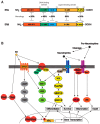Effect of Estradiol on Neurotrophin Receptors in Basal Forebrain Cholinergic Neurons: Relevance for Alzheimer's Disease
- PMID: 27999310
- PMCID: PMC5187922
- DOI: 10.3390/ijms17122122
Effect of Estradiol on Neurotrophin Receptors in Basal Forebrain Cholinergic Neurons: Relevance for Alzheimer's Disease
Abstract
The basal forebrain is home to the largest population of cholinergic neurons in the brain. These neurons are involved in a number of cognitive functions including attention, learning and memory. Basal forebrain cholinergic neurons (BFCNs) are particularly vulnerable in a number of neurological diseases with the most notable being Alzheimer's disease, with evidence for a link between decreasing cholinergic markers and the degree of cognitive impairment. The neurotrophin growth factor system is present on these BFCNs and has been shown to promote survival and differentiation on these neurons. Clinical and animal model studies have demonstrated the neuroprotective effects of 17β-estradiol (E2) on neurodegeneration in BFCNs. It is believed that E2 interacts with neurotrophin signaling on cholinergic neurons to mediate these beneficial effects. Evidence presented in our recent study confirms that altering the levels of circulating E2 levels via ovariectomy and E2 replacement significantly affects the expression of the neurotrophin receptors on BFCN. However, we also showed that E2 differentially regulates neurotrophin receptor expression on BFCNs with effects depending on neurotrophin receptor type and neuroanatomical location. In this review, we aim to survey the current literature to understand the influence of E2 on the neurotrophin system, and the receptors and signaling pathways it mediates on BFCN. In addition, we summarize the physiological and pathophysiological significance of E2 actions on the neurotrophin system in BFCN, especially focusing on changes related to Alzheimer's disease.
Keywords: Alzheimer’s disease; basal forebrain cholinergic neurons 4; estradiol 1; neurotrophin receptors 3; neurotrophins 2.
Conflict of interest statement
The authors declare no conflict of interest.
Figures

Similar articles
-
Estradiol modulation of neurotrophin receptor expression in female mouse basal forebrain cholinergic neurons in vivo.Endocrinology. 2015 Feb;156(2):613-26. doi: 10.1210/en.2014-1669. Epub 2014 Nov 21. Endocrinology. 2015. PMID: 25415243
-
Profiling Basal Forebrain Cholinergic Neurons Reveals a Molecular Basis for Vulnerability Within the Ts65Dn Model of Down Syndrome and Alzheimer's Disease.Mol Neurobiol. 2021 Oct;58(10):5141-5162. doi: 10.1007/s12035-021-02453-3. Epub 2021 Jul 14. Mol Neurobiol. 2021. PMID: 34263425 Free PMC article.
-
Small molecule modulation of TrkB and TrkC neurotrophin receptors prevents cholinergic neuron atrophy in an Alzheimer's disease mouse model at an advanced pathological stage.Neurobiol Dis. 2022 Jan;162:105563. doi: 10.1016/j.nbd.2021.105563. Epub 2021 Nov 24. Neurobiol Dis. 2022. PMID: 34838668
-
Basal forebrain cholinergic system in the dementias: Vulnerability, resilience, and resistance.J Neurochem. 2021 Sep;158(6):1394-1411. doi: 10.1111/jnc.15471. Epub 2021 Aug 6. J Neurochem. 2021. PMID: 34272732 Free PMC article. Review.
-
Role of estrogen replacement therapy in memory enhancement and the prevention of neuronal loss associated with Alzheimer's disease.Am J Med. 1997 Sep 22;103(3A):19S-25S. doi: 10.1016/s0002-9343(97)00260-x. Am J Med. 1997. PMID: 9344403 Review.
Cited by
-
Estrogen, menopause, and Alzheimer's disease: understanding the link to cognitive decline in women.Front Mol Biosci. 2025 Jun 30;12:1634302. doi: 10.3389/fmolb.2025.1634302. eCollection 2025. Front Mol Biosci. 2025. PMID: 40661313 Free PMC article. Review.
-
A Novel Prodrug Approach for Central Nervous System-Selective Estrogen Therapy.Molecules. 2019 Nov 19;24(22):4197. doi: 10.3390/molecules24224197. Molecules. 2019. PMID: 31752337 Free PMC article. Review.
-
Sex- and age-related changes in GABA signaling components in the human cortex.Biol Sex Differ. 2019 Jan 14;10(1):5. doi: 10.1186/s13293-018-0214-6. Biol Sex Differ. 2019. PMID: 30642393 Free PMC article.
-
Is Hormone Replacement Therapy a Risk Factor or a Therapeutic Option for Alzheimer's Disease?Int J Mol Sci. 2023 Feb 6;24(4):3205. doi: 10.3390/ijms24043205. Int J Mol Sci. 2023. PMID: 36834617 Free PMC article.
-
Liquid Contact-Selective Potentiometric Sensor Based on Imprinted Polymeric Beads Towards 17β-Estradiol Determination.Polymers (Basel). 2020 Jul 7;12(7):1506. doi: 10.3390/polym12071506. Polymers (Basel). 2020. PMID: 32645900 Free PMC article.
References
Publication types
MeSH terms
Substances
LinkOut - more resources
Full Text Sources
Other Literature Sources
Medical

